 After conquering the land, the Israelites claimed the site of Shiloh as the religious center of the nation, and there they placed the tabernacle. However, after Hophni and Phinehas lost the Ark of the Covenant in battle, the archaeological record indicates Shiloh was destroyed soon thereafter, possibly by Philistines following up their “victory” over Israel’s God by also destroying Shiloh.
After conquering the land, the Israelites claimed the site of Shiloh as the religious center of the nation, and there they placed the tabernacle. However, after Hophni and Phinehas lost the Ark of the Covenant in battle, the archaeological record indicates Shiloh was destroyed soon thereafter, possibly by Philistines following up their “victory” over Israel’s God by also destroying Shiloh.
[soundcloud url="https://api.soundcloud.com/tracks/189042930" params="auto_play=false&hide_related=false&show_comments=true&show_user=true&show_reposts=false&visual=true" width="100%" height="450" iframe="true" /] In Psalm 125, the psalmist draws a beautiful comparison between the mountains of Jerusalem and the love and protection that God provides to His people. But, in order to fully appreciate what the psalmist means, you have to have an complete understanding of the geography of Jerusalem. That is what we will be discussing on this program.
Podcast Links Jerusalem Post Article concerning 2013 Jerusalem Marathon 2015 Israel Tour
 In I Samuel 14, Jonathan and his armor bearer perform a daring raid on the Philistine garrison in Michmash, just north of Jerusalem. Separating the enemies from the Israelite camp at Gibeah is a deep ravine punctuated by sheer cliffs on each side. This photo would be in the general area and it fits the physical description. It’s certainly a good visual backdrop for this passage.
In I Samuel 14, Jonathan and his armor bearer perform a daring raid on the Philistine garrison in Michmash, just north of Jerusalem. Separating the enemies from the Israelite camp at Gibeah is a deep ravine punctuated by sheer cliffs on each side. This photo would be in the general area and it fits the physical description. It’s certainly a good visual backdrop for this passage.
 Dogs have always been a valuable asset to humanity, especially during ancient times when their help was needed in herding and protecting other domesticated animals. This purpose has not diminished, as scrappy mongrels can often be spotted among flocks of sheep and goats, or keeping a weather eye on their masters’ donkeys in the heat of the day, such as this faithful guardian at Petra.
Dogs have always been a valuable asset to humanity, especially during ancient times when their help was needed in herding and protecting other domesticated animals. This purpose has not diminished, as scrappy mongrels can often be spotted among flocks of sheep and goats, or keeping a weather eye on their masters’ donkeys in the heat of the day, such as this faithful guardian at Petra.
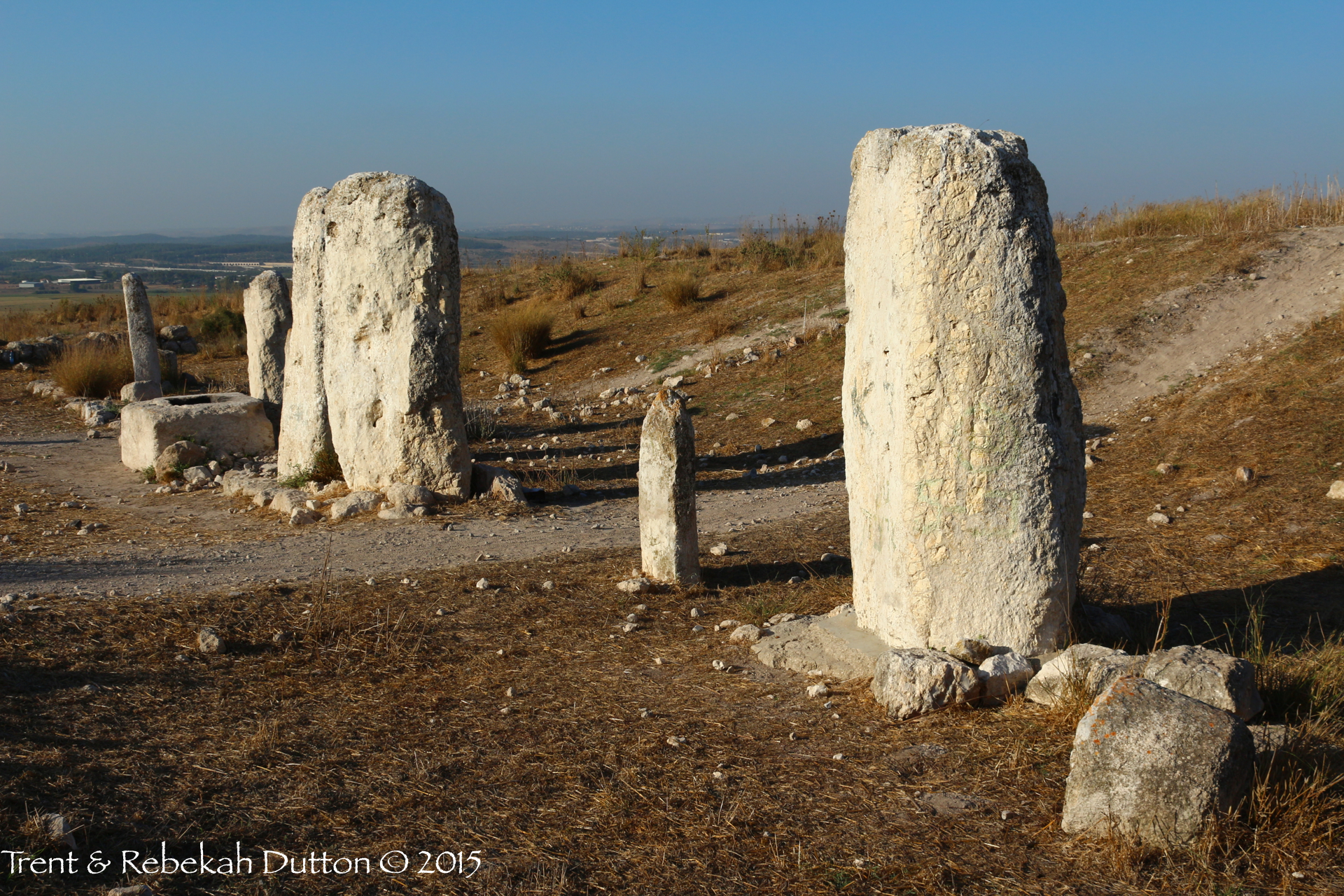 At the site of Gezer in the Shephelah, one cannot miss the beautiful limestone mazzeboth (standing stones), the tallest measuring around 12 feet high. These particular standing stones were likely erected during the Canaanite period, but they likely served to memorialize an event, such as a treaty which may have taken place at Gezer. This illustrates the common practice mentioned in the Biblical narrative when individuals set up a stone of memorial, such as Jacob in Bethel (Genesis 28:18) and Samuel with the Ebenezer (1 Samuel 7:12, literally meaning “rock of help”).
At the site of Gezer in the Shephelah, one cannot miss the beautiful limestone mazzeboth (standing stones), the tallest measuring around 12 feet high. These particular standing stones were likely erected during the Canaanite period, but they likely served to memorialize an event, such as a treaty which may have taken place at Gezer. This illustrates the common practice mentioned in the Biblical narrative when individuals set up a stone of memorial, such as Jacob in Bethel (Genesis 28:18) and Samuel with the Ebenezer (1 Samuel 7:12, literally meaning “rock of help”).
 These two idols from the Oriental Institute in Chicago are thought to represent the gods El (left) and Ba’al (right), are often mentioned in the Biblical narrative. The mythology behind this father-son pair comes mostly from the Bronze Age city of Ugarit (1450-1200 BC). While El and his consort Asherah were the chief gods, Ba’al was the powerful storm god who achieved great victories over the sea and death with the aid of his sister, Anath.
These two idols from the Oriental Institute in Chicago are thought to represent the gods El (left) and Ba’al (right), are often mentioned in the Biblical narrative. The mythology behind this father-son pair comes mostly from the Bronze Age city of Ugarit (1450-1200 BC). While El and his consort Asherah were the chief gods, Ba’al was the powerful storm god who achieved great victories over the sea and death with the aid of his sister, Anath.
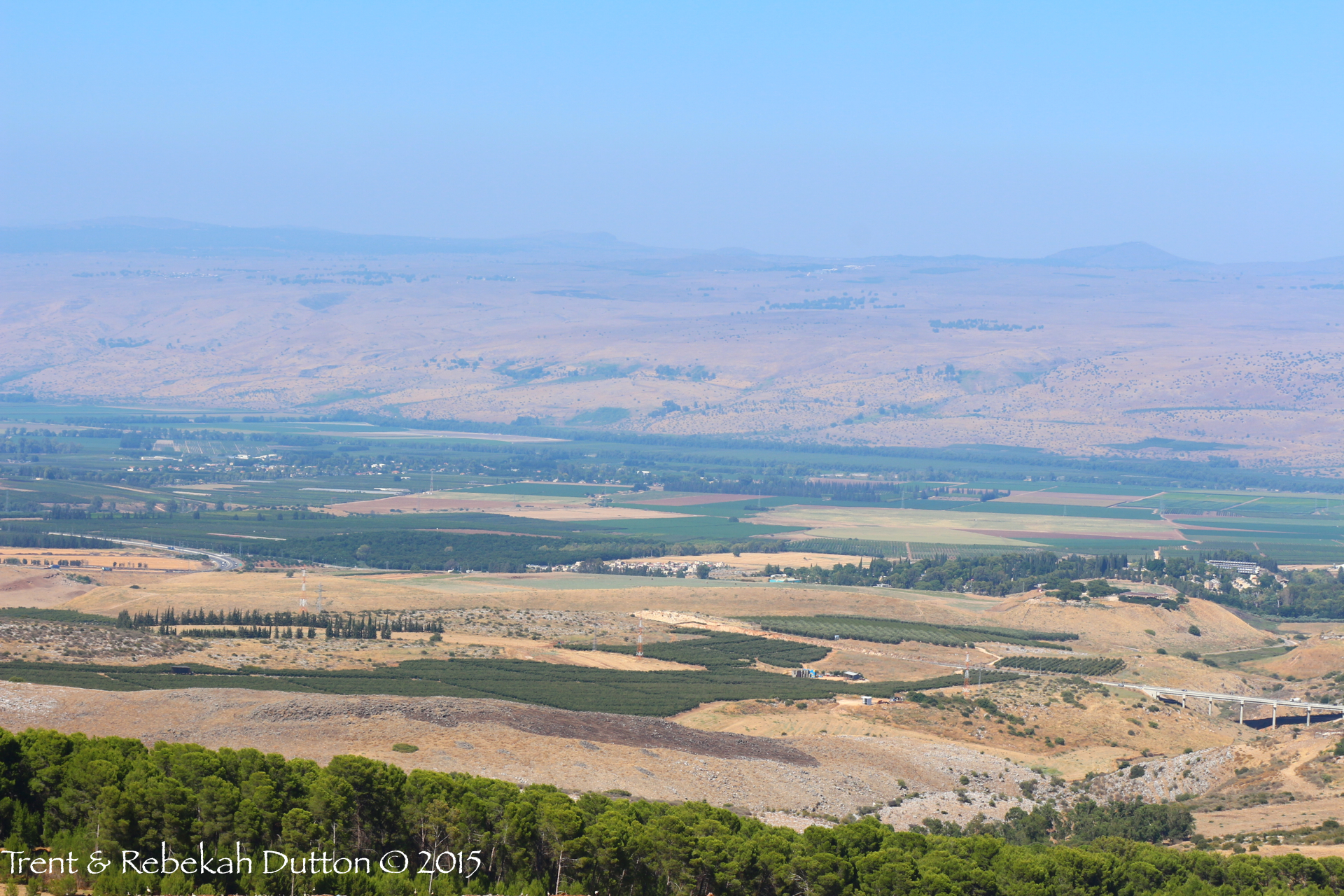 The ancient tell of Hazor is one of the largest sites in Israel at around 200 acres. However, the Iron Age Israelite occupation is mostly isolated to the upper city (the hill just above the modern bridge in the lower right corner), which features a beautiful Solomonic gate. As with so many important cities in the Levant, Hazor’s greatest value was its strategic position in the narrow pass into the Huleh Basin, a road that connected the Southern Levant to Damascus.
The ancient tell of Hazor is one of the largest sites in Israel at around 200 acres. However, the Iron Age Israelite occupation is mostly isolated to the upper city (the hill just above the modern bridge in the lower right corner), which features a beautiful Solomonic gate. As with so many important cities in the Levant, Hazor’s greatest value was its strategic position in the narrow pass into the Huleh Basin, a road that connected the Southern Levant to Damascus.
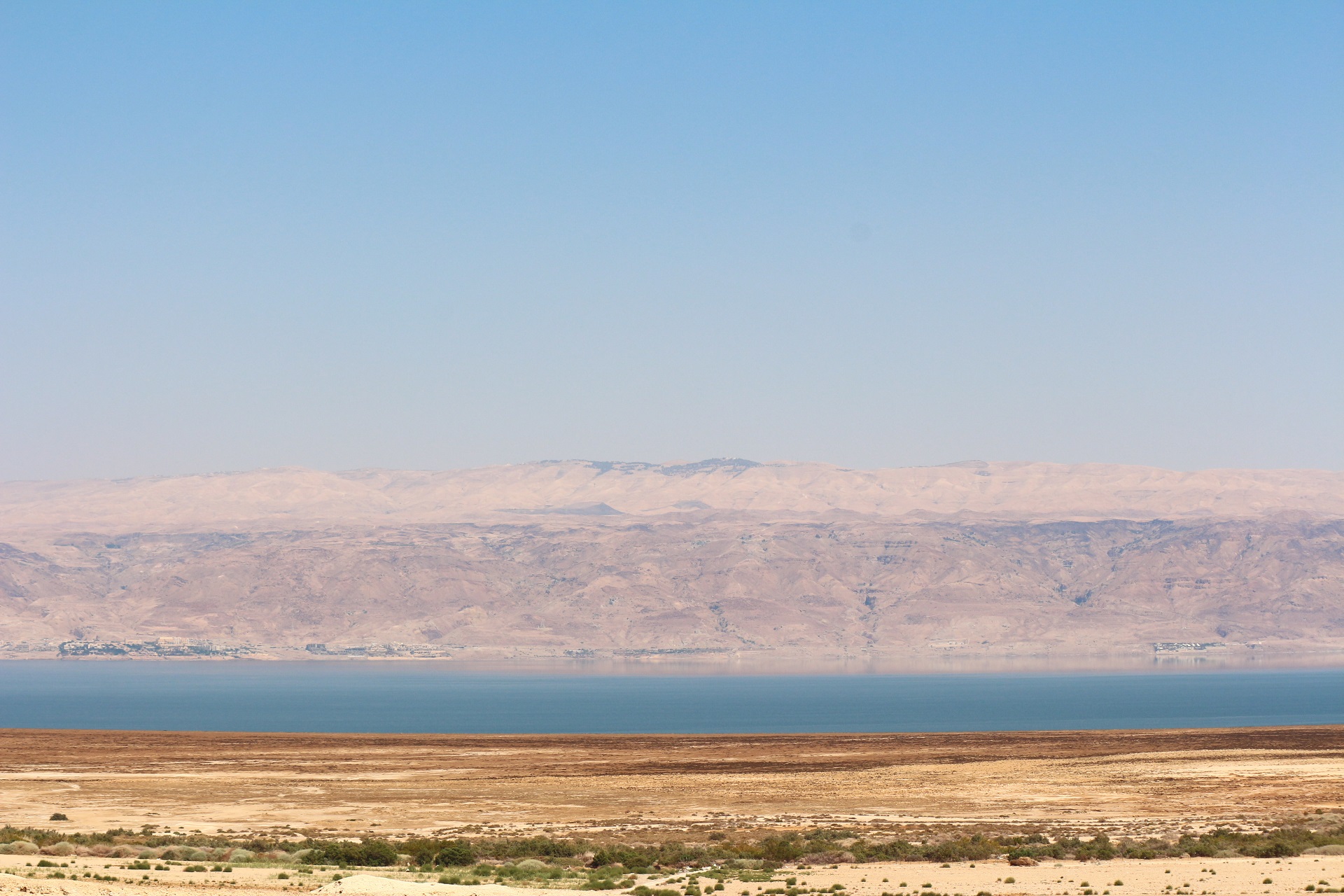 As with many places mentioned in the Bible, we may not know where the exact location is, but we can know it is “here.” The exact point of Mt. Nebo may not be known, but from Deuteronomy 32:49, we know that if we are in Jericho and look across to Moab, we should be looking in the direction of Mt. Nebo. This a view similar to what you would see from Jericho, just down the Dead Sea coast slightly (from Qumran, of Dead Sea Scrolls’ fame).
As with many places mentioned in the Bible, we may not know where the exact location is, but we can know it is “here.” The exact point of Mt. Nebo may not be known, but from Deuteronomy 32:49, we know that if we are in Jericho and look across to Moab, we should be looking in the direction of Mt. Nebo. This a view similar to what you would see from Jericho, just down the Dead Sea coast slightly (from Qumran, of Dead Sea Scrolls’ fame).
[soundcloud url="https://api.soundcloud.com/tracks/186283773" params="auto_play=false&hide_related=false&show_comments=true&show_user=true&show_reposts=false&visual=true" width="100%" height="300" iframe="true" /] In 1 Samuel 12, as Samuel is growing old, he takes the time to address the nation of Israel one last time. At the end of his speech, he asks God for a sign. God then sends a thunderstorm. The text then tells us that the people "greatly feared the Lord and Samuel". Why? Well, to fully understand the answer to the question, you need to know a little bit about the geography of Israel. That is what we will discuss in today's program.
You can subscribe to this podcast by searching for "Exploring Bible Lands" in iTunes, or by using our podcast feed URL (http://feeds.soundcloud.com/users/soundcloud:users:132866789/sounds.rss) in any podcast subscription application.
Podcast Links 1 Samuel 12 - BibleGateway.com 2015 Israel Tour Exploring Bible Lands' Facebook Page
 The Arbel cliff is beautiful, but also strategic in its position overlooking the pass into Galilee. This natural caves system was enlarged and used for inhabitation, first by Jews during the Hellenistic period, and later by Galilean Zealots fleeing Herod the Great. The basalt fortification seen today is the handiwork of a 17th-century Druze emir, built to protect the surrounding area. The Druze are a culturally Arab religious sect who reinterprets the teachings of Judaism, Christianity, and Islam.
The Arbel cliff is beautiful, but also strategic in its position overlooking the pass into Galilee. This natural caves system was enlarged and used for inhabitation, first by Jews during the Hellenistic period, and later by Galilean Zealots fleeing Herod the Great. The basalt fortification seen today is the handiwork of a 17th-century Druze emir, built to protect the surrounding area. The Druze are a culturally Arab religious sect who reinterprets the teachings of Judaism, Christianity, and Islam.
 It is often easy to forget that the characters we read about in the Bible and in the history books were real people, and lived much like we do today. Even the children of the ancient world loved to play and had toys, like this wheeled bear and otter from the early Iron Age (11th-10th century) Beit Shemesh, as well as dolls made of bone and clay, and board games with dice.
It is often easy to forget that the characters we read about in the Bible and in the history books were real people, and lived much like we do today. Even the children of the ancient world loved to play and had toys, like this wheeled bear and otter from the early Iron Age (11th-10th century) Beit Shemesh, as well as dolls made of bone and clay, and board games with dice.
 In a land where everything is old, and one can hardly go on a walk without tripping over an antiquity, ancient sites can sometimes be forgotten and fall into decay after excavations are over. Tell Miqne, better known as Biblical Ekron, lies unnoticed in the middle of a kibbutz‘s agricultural field, surrounded by cotton and watermelons.
In a land where everything is old, and one can hardly go on a walk without tripping over an antiquity, ancient sites can sometimes be forgotten and fall into decay after excavations are over. Tell Miqne, better known as Biblical Ekron, lies unnoticed in the middle of a kibbutz‘s agricultural field, surrounded by cotton and watermelons.
 About three years ago, I heard about the upcoming release of Jerusalem, the IMAX movie from National Geographic. It looked wonderful and I could not wait to see it. I wrote a blog post about the official trailer and then another blog post discussing the scenes in the trailer. I also wrote a couple of additional blog posts involving pictures of Golgotha and the Temple Mount which were provided by the movie.
About three years ago, I heard about the upcoming release of Jerusalem, the IMAX movie from National Geographic. It looked wonderful and I could not wait to see it. I wrote a blog post about the official trailer and then another blog post discussing the scenes in the trailer. I also wrote a couple of additional blog posts involving pictures of Golgotha and the Temple Mount which were provided by the movie.
According to the website, the release of the movie was to take place at science theatres across the world. I live near Huntsville, Alabama, the home of the United States Space & Rocket Center (USSRC), the largest space museum in the country. I was hopeful that it would be on the list of theatres, but it was not. We were finally able to see the movie a little over a year ago in Tallahassee, Florida, on our way to see family for the Thanksgiving holiday.
Yesterday, we learned that USSRC began showing Jerusalem two days ago. This morning, we went to the theatre and enjoyed this wonderful movie again. If you want, you can read my review of the movie from our first viewing. The nice thing that was an added bonus was the grab bag that they gave to every person. It contained a huge poster of Jerusalem, with facts about the city. There was also a handout as well as a DVD with many features about the film. It was a nice surprise that I look forward to investigating further.
If you are a student of the Bible and you live in the North Alabama area, I encourage you to go to the United States Space & Rocket Center and see this movie. You can check their website for showtimes and prices. I am not sure how long the grab bag extra will last, so you might check with that when you get there.
Do you want to go to Jerusalem? Then join me this October for my 2015 Bible Study Tour of Israel!
 As we try to continuously bring alive the people, places, and culture of the Biblical text, the small things are not to be ignored. While people of those days are millennia away from us, and we may not fully understand their culture and ancient history, they were people, just like you and me. When a Biblical writer speaks of flowers, the message they intend to convey can be seen by us. Flowers may bring to mind James 1:9-11, and the message of fading riches. These daisies, particularly the center one with yellow and white, adorn the ancient rocks of the Athens acropolis, with the same colors now as they would have displayed in ancient times.
As we try to continuously bring alive the people, places, and culture of the Biblical text, the small things are not to be ignored. While people of those days are millennia away from us, and we may not fully understand their culture and ancient history, they were people, just like you and me. When a Biblical writer speaks of flowers, the message they intend to convey can be seen by us. Flowers may bring to mind James 1:9-11, and the message of fading riches. These daisies, particularly the center one with yellow and white, adorn the ancient rocks of the Athens acropolis, with the same colors now as they would have displayed in ancient times.
 An odeon, another name for a theater type structure, was a building or open air theater built by the Greeks and Romans for music, poetry readings, and other similar events. Paul is again brought to mind and his encounter with certain Ephesians in their “theater” with troubles over one of their gods (Acts 19). This Odeon of Herodes Atticus (a Greek who served as a Roman senator), is well preserved and partially restored, resting at the base of the Athens acropolis. Images like these show a concept such as the ancient theater was spread throughout the Greek and Roman world. Caesarea Maritima, on the Mediterranean shores of Israel, holds another well preserved and restored theater such as this.
An odeon, another name for a theater type structure, was a building or open air theater built by the Greeks and Romans for music, poetry readings, and other similar events. Paul is again brought to mind and his encounter with certain Ephesians in their “theater” with troubles over one of their gods (Acts 19). This Odeon of Herodes Atticus (a Greek who served as a Roman senator), is well preserved and partially restored, resting at the base of the Athens acropolis. Images like these show a concept such as the ancient theater was spread throughout the Greek and Roman world. Caesarea Maritima, on the Mediterranean shores of Israel, holds another well preserved and restored theater such as this.
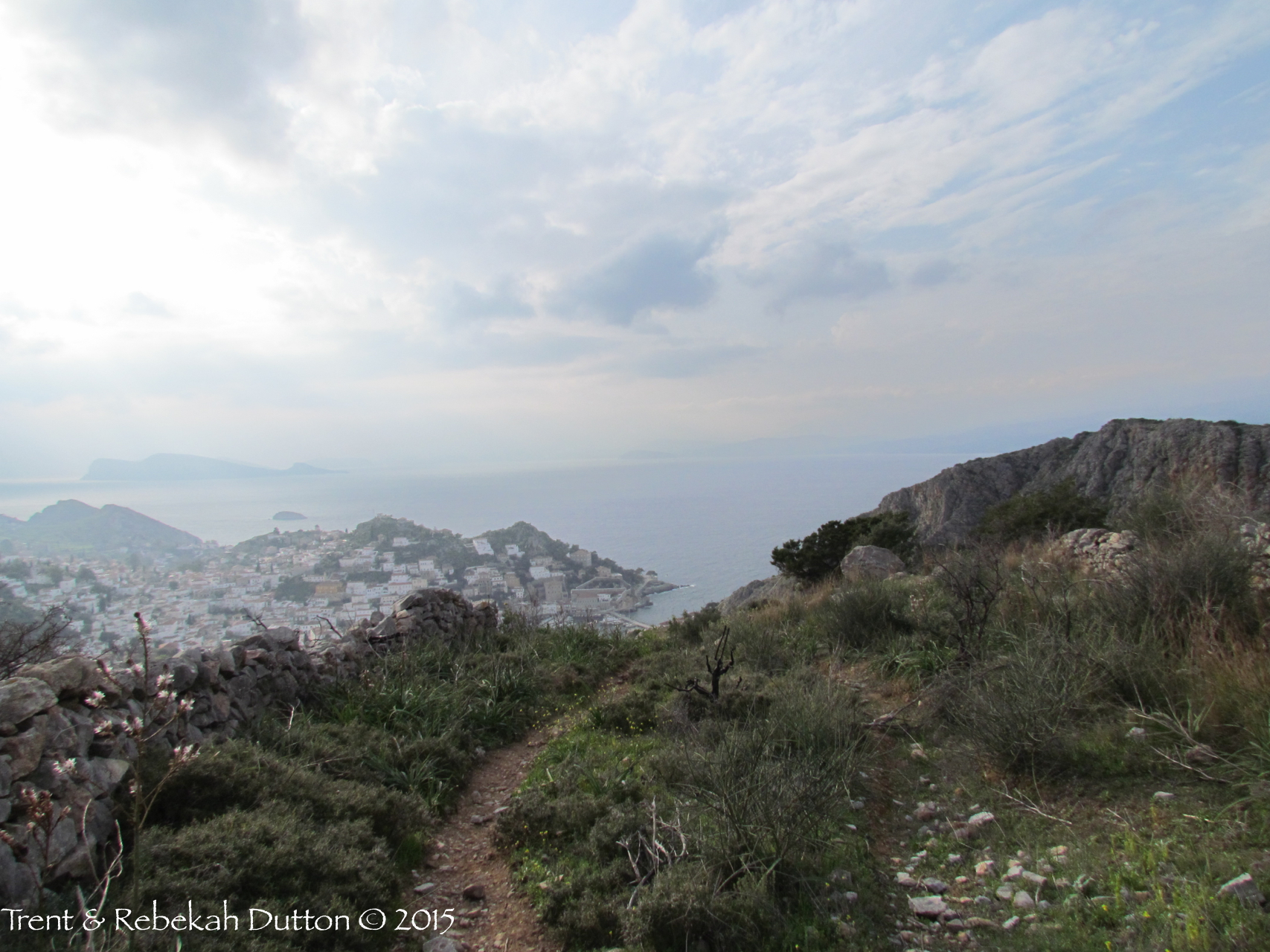 This view is not from Athens or the Greek mainland, but from one of the Greek Islands, looking northwest. While this particular island has no known Biblical significance, it provides a vista in helping to understand the region of the Greek Peloponnese Islands (think of the apostle’s voyages across the Mediterranean). While Athens was on the Greek mainland, Greeks were scattered across these islands. The most concentrated gathering of Greeks, particularly those of nationalistic Greek influence and action, would have been in Athens. However, since even before the first century AD, inhabitants of these islands would band together to fight common foes.
This view is not from Athens or the Greek mainland, but from one of the Greek Islands, looking northwest. While this particular island has no known Biblical significance, it provides a vista in helping to understand the region of the Greek Peloponnese Islands (think of the apostle’s voyages across the Mediterranean). While Athens was on the Greek mainland, Greeks were scattered across these islands. The most concentrated gathering of Greeks, particularly those of nationalistic Greek influence and action, would have been in Athens. However, since even before the first century AD, inhabitants of these islands would band together to fight common foes.
This shot is from the Greek island of Hydra (pronounced E-dra). If you are ever in Athens and have a day or two to spare, this beautiful island (which has no cars!...only donkeys and foot traffic) is a great relaxing spot with many quaint guest houses and plentiful walking trails with picturesque views of the Aegean Sea.
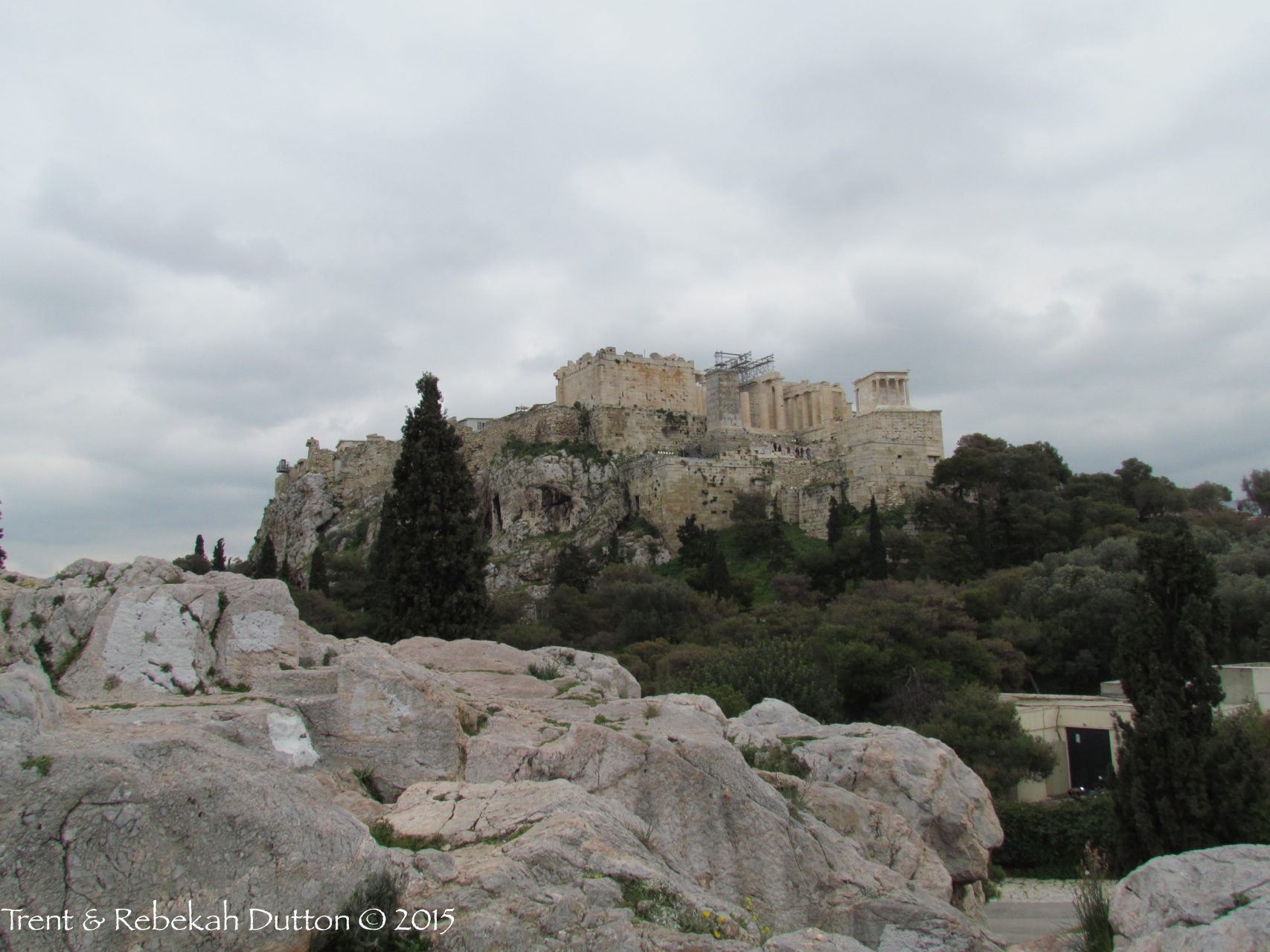 Yesterday’s view was from the Acropolis of Athens, today’s view is the Acropolis itself. This view is from what is thought to be the Areopagus, where Paul addressed the citizens of Athens following his observation mentioned yesterday, of the cities religious inclinations. Paul had a different message from what the inhabitants were accustomed to.
Yesterday’s view was from the Acropolis of Athens, today’s view is the Acropolis itself. This view is from what is thought to be the Areopagus, where Paul addressed the citizens of Athens following his observation mentioned yesterday, of the cities religious inclinations. Paul had a different message from what the inhabitants were accustomed to.